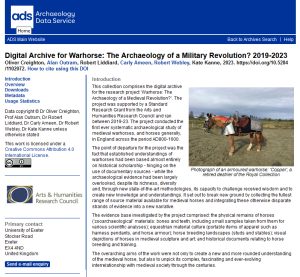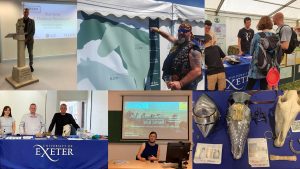This blog marks the conclusion of the formal funded phase of our AHRC Warhorse project, but our work of course continues as we develop publications and use the project’s achievements as a platform for future funding bids and other initiatives. So please do watch this blog for future updates.
The following account draws on the end of project statement submitted to our funders to first flag some of our key research achievements and, secondly, to reflect on how our research is having an impact on the wider world.
The headline is that our project succeeded in carrying out the first ever systematic and integrated study of the full range of archaeological evidence for warhorses and horses in medieval England — from scientific samples extracted from teeth through to analysis of bones, equestrian artefacts and armour, and the sites and landscapes associated with horse breeding and training.
Key Findings
The work has created new knowledge on three main fronts:
First, in the field of zooarchaeology the project applied cutting-edge GMM (Geometric Morphometric) and isotopic sampling methodologies to medieval horses for the first time. This has enabled the skeletal signatures of breeding and training regimes to be ascertained and for the biographies of individual horses to be revealed, and highlighted Europe-wide movements of breeding stock in a case study site in London. A headline finding about horse stature from a project database of 8500+ bones is that most medieval horses were below the size of modern ponies (1.48m to the withers, or shoulder), and detailed measurement of over 130 items of horse armour confirms the findings suggested from bone evidence. While popular perceptions of medieval warhorses picture large beasts, not a single bone from the entire project indicated a medieval horse that would have met the size criteria for a modern police horse (1.68m). Our zooarchaeology dataset is one of several important resources that we have now uploaded to the Archaeology Data Service website (https://archaeologydataservice.ac.uk/archives/view/1005150/) where they are freely available for researchers.
Image of the ADS homepage where datasets from our work can be accessed and downloaded.
Second, in the field of landscape history, the work has generated entirely new information about an aspect of the medieval countryside (the horse stud) that had been neglected. Over 800 medieval documents have been examined to provide information on the nature and organisation of studs, principally during the High Middle Ages. The project produced the first ever mapping of the English royal stud network, clarified the number and location of stud sites (within parks), characterised their landscape contexts (frequently in uplands or wetland zones), and reconstructed their hinterlands. The work highlighted that while studs can be located to places, physical traces of their buildings and infrastructure are exceptionally ephemeral. It has also drawn attention to the tendency to misidentify equine structures, especially stables, as being for other livestock and purposes.
Third, in terms of debates within medieval archaeology and history the project has provided new evidence for continuity and/or change across the Saxo-Norman divide by highlighting that in terms of equestrian material culture the Norman Conquest had a minimal signature, with the introduction of the curb bit the principal indicator of change. Mapping of equestrian material culture from a project database of 14,000+ separate artefacts shows great potential, previously unrecognised, to map the footprints of medieval tournament sites and (through harness pendants decorated with arms and symbols) noble families. Follow the ADS link above to access our online dataset.
As an overall methodological achievement, the project’s integrated approach has made a powerful statement about how barriers between traditionally discrete research fields can be broken down to produce new understandings. In answer to the key questions of (1) whether we can identify warhorses in the archaeological record; and (2) whether the warhorse was a breed, a selection or some sort of cultural product, we can reach some preliminary conclusions by combining all our lines of evidence. First, it is rare for warhorses to be deposited in archaeological contexts which clearly identify the function and role of the animals. It is, however, clear that exceptional care was taken to breed and train appropriate horses, including importing or being gifted suitable animals from overseas. Whilst selective breeding in a stud network formed a key part of warhorse management, the destrier cannot be considered to be a ‘breed’. It more likely represents a selection for appropriate temperament and body conformation, accompanied by intensive training that resulted in highly valuable steeds. Warhorses might additionally be marked out to some degree by activity-related bone remodelling and pathologies. While the ‘great horse’ was likely of a larger stature than the average medieval equid, the metrical evidence from animal bones, horse armour and other material culture, suggests that raw size was considered less of a key trait than the physical and mental characteristics highlighted above.
Impact
The impact of the project on wider non-academic audiences and stakeholders was of central importance to our work. The key areas of impact, recorded through the period of the funded project (Feb 2019-March 2023), fall into four areas.
First, the project generated benefits for our partner organisations. The Portable Antiquities Scheme, run through the British Museum, benefitted from the delivery of three intensive training workshops on recording equestrian artefacts to over 100 staff and volunteers and from the delivery of 10 freely available finds guides to help metal detectorists record items such as harness pendants and horseshoes (see https://finds.org.uk/counties/findsrecordingguides/guides-by-use-and-function/horses-and-transport/). According to the Head of the Portable Antiquities Scheme: “What is most important is that the work of the results of the project’s partnership working – the training workshops and freely-accessible finds guides – have a legacy, transforming the way that staff and public volunteers record metal-detected equestrian objects” (Professor Michael Lewis, 2023). The Royal Armouries benefited from the experience of working with an academic partner, including enhancement to its catalogue and records, opportunities for the co-publication of results, and enrichment of outreach activities (the project had a presence at two public events run by the Armouries attended by over 17,000 members of the public).
Second, the project is playing a key role in changing public perceptions about the size and appearance of medieval horses, which are often based on experiences of film and TV. A press release which accompanied a project publication in The International Journal of Osteoarchaeology generated 197 press articles in 34 countries, while project staff have contributed through the podcasts and programmes including BBC Radio 4 ‘In Our Time’ to reach mass public audiences. The project had a presence at five large public events attracting 41,400 members of the public in total and generating reactions from participants such as “I had no idea a medieval warhorse could be so small; it’s fascinating to hear that historical films can get it so badly wrong!”
Third, the project’s findings have been actively promoted and disseminated on the national and international conference circuit, with staff speaking at 18 separate events in the UK to reach in excess of 750 participants and 15 events in a further 10 countries reaching a minimum of 550 participants.
Compilation image of outreach events and lectures involving members of the Warhorse team
Fourth, the academic impact of the work is having knock-on effects for the way that equestrian heritage is presented in museums and heritage sites. For example, Historic Royal Palaces reported in January 2023 that their website for Hampton Court has been amended to reflect our project’s findings. Another example is the way that English Heritage’s newly installed signage and the new (2022) official guidebook for Launceston Castle, Cornwall, now recognise a building on the site, which was previously misidentified, as a medieval stable, on the basis of the project’s findings.
Beyond these impacts, the high level of public interest in all manner of equine pursuits, such as show jumping and horse racing, is likely to open up opportunities for further aspects of public engagement, which the project will exploit, including through a Follow-on-Funding Bid.
With so much to shout about, and such exciting possibilities for the future I can only end this blog with the most enormous thank you to the incredible, energetic team of talented researchers that have driven the work forward, as well as to our project partners and everybody who has shown an interest. But the work continues…

